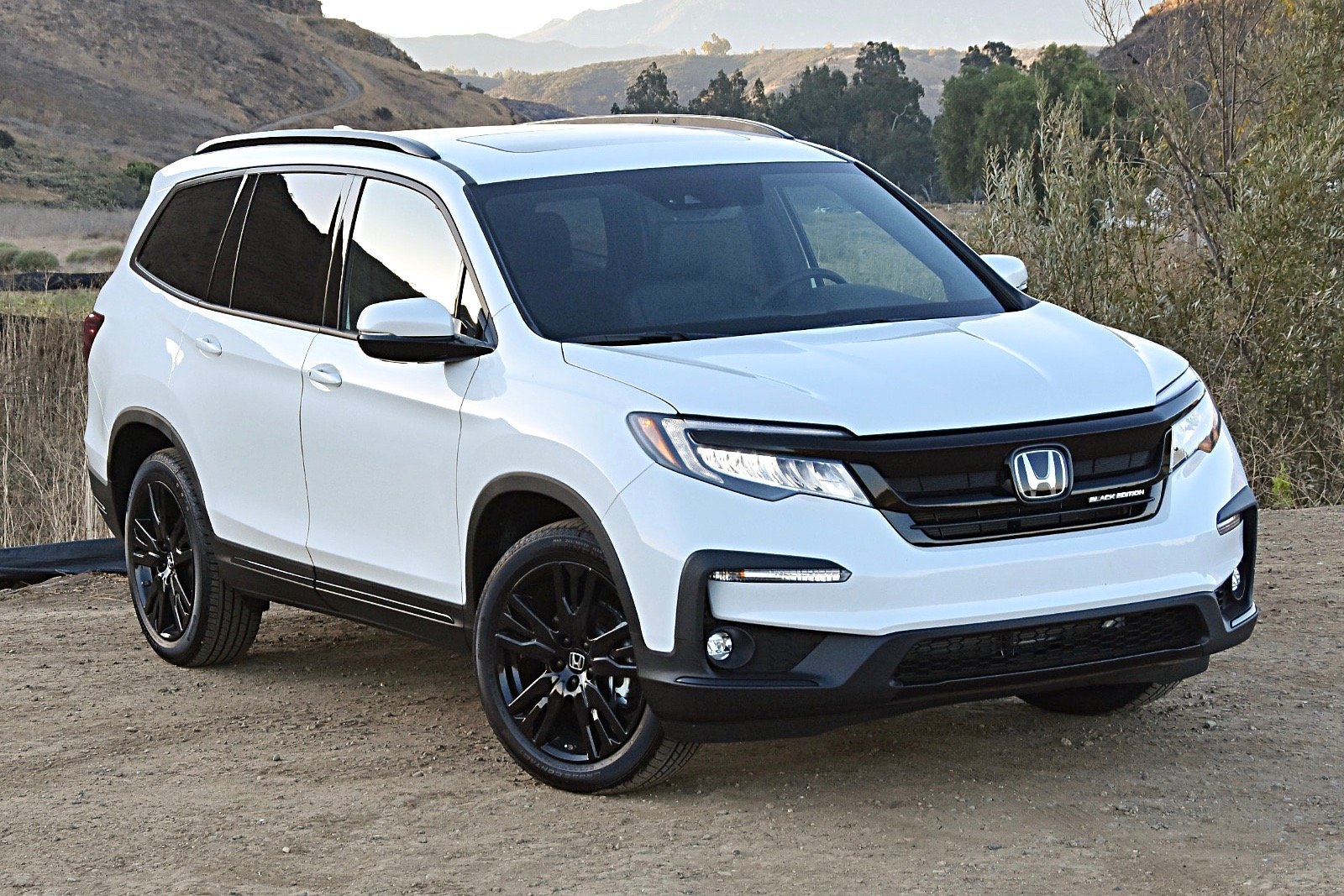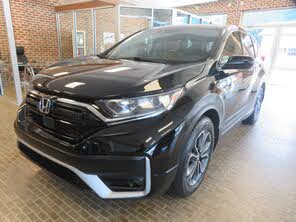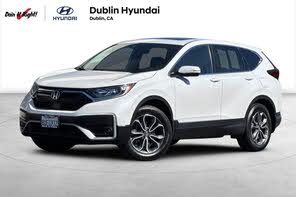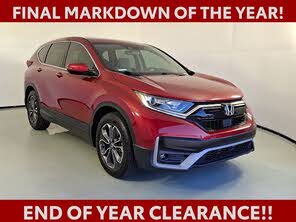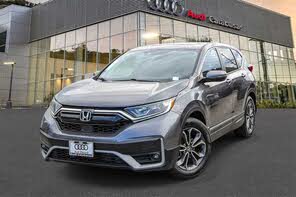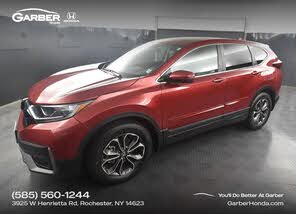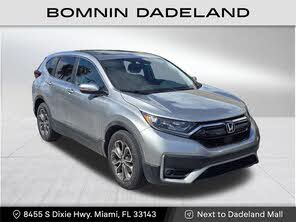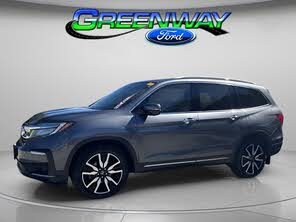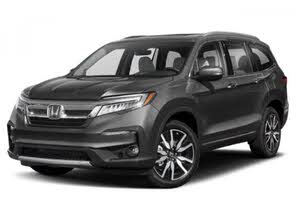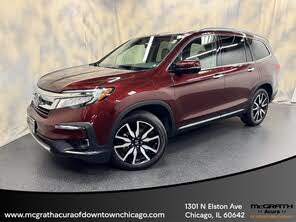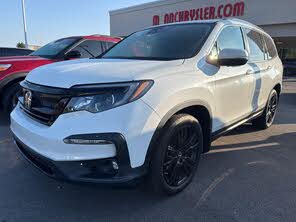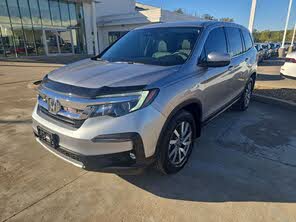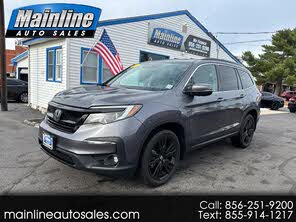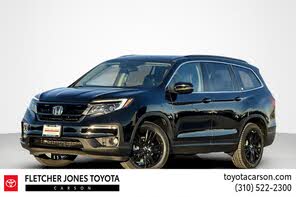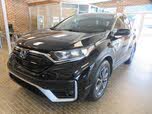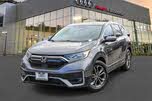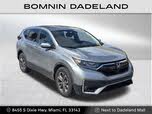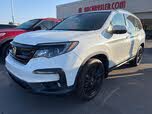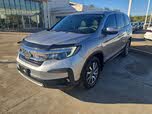2020 Honda CR-V vs 2021 Honda Pilot
Overview | |
MSRP$25,150 | MSRP$32,550 |
Listings1672 | Listings994 |
Ratings & Reviews | |
User Reviews | User Reviews |
Expert reviews7.5 out of 10 | Expert reviews7.2 out of 10 |
Pros
Cons
| Pros
Cons
|
2020 Honda CR-V Reviews SummaryHonda’s compact SUV has been satisfying buyers for more than two decades, with more than five million CR-V’s sold. Such a legacy means the CR-V has long had its wrinkles smoothed out into a comfortable and capable crossover package that’s only downside may be its sheer inoffensiveness. This year’s model gets engine and safety upgrades, which improve fuel economy and help to make Honda’s bestseller an even better value. | |
2021 Honda Pilot Reviews SummaryIt’s been seven years since Honda last redesigned the Pilot, the automaker’s popular midsize three-row crossover SUV. In most ways, age has been kind to it, but to love a 2021 Honda Pilot you must first live with one. Unlike some competitors, the styling is not a strong suit. Rather, it is the Pilot’s interior, powertrain, driving dynamics, and simple but useful technology that makes you appreciate it each and every day. Well, that, and the cheap lease payment. | |
No video found | No video found |
Popular Features & Specs | |
Engine1.5L 190 hp I4 | Engine3.5L 280 hp V6 |
Drive TrainFWD | Drive TrainFWD |
Seating Capacity5 | Seating Capacity8 |
Horsepower190 hp @ 5600 rpm | Horsepower280 hp @ 6000 rpm |
MPG City28 | MPG City20 |
MPG Highway34 | MPG Highway27 |
Engine | |
Engine Name1.5L 190 hp I4 | Engine Name3.5L 280 hp V6 |
Torque179 lb-ft @ 2000 rpm | Torque262 lb-ft @ 4700 rpm |
Horsepower190 hp @ 5600 rpm | Horsepower280 hp @ 6000 rpm |
DrivetrainFWD | DrivetrainFWD |
Fuel Economy | |
MPG City28 | MPG City20 |
MPG Highway34 | MPG Highway27 |
Interior | |
Seating Capacity5 | Seating Capacity8 |
Safety | |
Front Crash Overall5 | Front Crash Overall4 |
Side Crash Overall5 | Side Crash Overall5 |
Dimensions & Capacity | |
Cargo Space39.2 cu ft | Cargo Space16.5 cu ft |
Curb Weight3337 lbs | Curb Weight3982 lbs |
Height66.1 in | Height70.6 in |
Length182.1 in | Length196.5 in |
Width73.0 in | Width78.6 in |
Wheelbase104.8 in | Wheelbase111.0 in |
Maximum Payload1358 lbs | Maximum Payload1563 lbs |
Number of doors4 | Number of doors4 |
Maximum Towing Capacity1500 lbs | Maximum Towing Capacity3500 lbs |
Overview | ||
MSRP | $25,150 | $32,550 |
Listings | ||
Ratings & Reviews | ||
User reviews | ||
Expert reviews | 7.5 out of 10Read full review | 7.2 out of 10Read full review |
Pros & cons | Pros
Cons
| Pros
Cons
|
Summary | Honda’s compact SUV has been satisfying buyers for more than two decades, with more than five million CR-V’s sold. Such a legacy means the CR-V has long had its wrinkles smoothed out into a comfortable and capable crossover package that’s only downside may be its sheer inoffensiveness. This year’s model gets engine and safety upgrades, which improve fuel economy and help to make Honda’s bestseller an even better value. | It’s been seven years since Honda last redesigned the Pilot, the automaker’s popular midsize three-row crossover SUV. In most ways, age has been kind to it, but to love a 2021 Honda Pilot you must first live with one. Unlike some competitors, the styling is not a strong suit. Rather, it is the Pilot’s interior, powertrain, driving dynamics, and simple but useful technology that makes you appreciate it each and every day. Well, that, and the cheap lease payment. |
Video | No video found | No video found |
Popular Features & Specs | ||
Engine | 1.5L 190 hp I4 | 3.5L 280 hp V6 |
Drive Train | FWD | FWD |
Seating Capacity | 5 | 8 |
Horsepower | 190 hp @ 5600 rpm | 280 hp @ 6000 rpm |
MPG City | 28 | 20 |
MPG Highway | 34 | 27 |
Engine | ||
Engine Name | 1.5L 190 hp I4 | 3.5L 280 hp V6 |
Torque | 179 lb-ft @ 2000 rpm | 262 lb-ft @ 4700 rpm |
Horsepower | 190 hp @ 5600 rpm | 280 hp @ 6000 rpm |
Drivetrain | FWD | FWD |
Fuel Economy | ||
MPG City | 28 | 20 |
MPG Highway | 34 | 27 |
Interior | ||
Seating Capacity | 5 | 8 |
Safety | ||
Front Crash Overall | 5 | 4 |
Side Crash Overall | 5 | 5 |
Dimensions & Capacity | ||
Cargo Space | 39.2 cu ft | 16.5 cu ft |
Curb Weight | 3337 lbs | 3982 lbs |
Height | 66.1 in | 70.6 in |
Length | 182.1 in | 196.5 in |
Width | 73.0 in | 78.6 in |
Wheelbase | 104.8 in | 111.0 in |
Maximum Payload | 1358 lbs | 1563 lbs |
Number of doors | 4 | 4 |
Maximum Towing Capacity | 1500 lbs | 3500 lbs |
The 2020 Honda CR-V, part of Honda's fifth generation of compact crossovers, had a design that was both familiar and enjoyable. Its exterior styling was characterized by soft, curvy lines that gave it a car-like appearance, reminiscent of Honda's sedan lineup. The CR-V's design leaned more towards a station wagon than an SUV, making it a modern choice for family transportation. However, the interior was a mix of textures and materials, with upscale touches like wood-look trim and leather upholstery clashing with lower-quality plastics. This contrast reminded drivers that even the pricier CR-V models were essentially upgraded versions of a commodity car rather than premium products.
In contrast, the 2021 Honda Pilot aimed to solve the styling puzzle with a rugged appearance introduced in a 2019 refresh and a blacked-out look in the 2020 Black Edition. Despite these efforts, the Pilot's exterior design remained an acquired taste. The 2021 model offered seven different versions, ranging from the base LX to the upscale Black Edition, with prices spanning from $32,250 to $49,920. The new Special Edition trim added black 20-inch alloy wheels, wireless smartphone charging, and a hands-free power tailgate. The Pilot's interior featured quality materials, including black leather upholstery with red accents in the Black Edition, but its design resembled a minivan, which didn't do the SUV any favors.

















The 2020 Honda CR-V featured a 1.5-liter turbocharged engine, producing 190 horsepower and 179 pound-feet of torque, paired with a continuously variable automatic transmission (CVT). This powertrain provided a well-matched driving experience, with the CR-V feeling quick, especially in Sport mode. The CR-V's road manners were excellent, with nimble handling and a firm yet comfortable chassis. Its low curb weight of 3,337 pounds contributed to its agility and fuel efficiency, with FWD models achieving 30 mpg combined and AWD models 29 mpg. The CR-V's fuel economy was among the best in its class, matching the Subaru Forester and surpassing the Ford Escape and Toyota RAV4.
The 2021 Honda Pilot, on the other hand, was equipped with a 3.5-liter V6 engine, delivering 280 horsepower and 262 pound-feet of torque. This engine provided smooth and refined power, making the SUV quick to accelerate. A nine-speed automatic transmission powered the front wheels, with an available torque-vectoring AWD system for enhanced traction. The Pilot's fuel-saving features included variable-cylinder management and automatic engine stop/start, resulting in an EPA rating of 22 mpg combined for AWD models. The Pilot offered a comfortable ride and unexpectedly athletic handling, thanks to its suspension setup and torque-vectoring AWD system. However, its off-road capability was limited by modest ground clearance and all-season tires.
The 2020 Honda CR-V excelled in interior space and storage solutions. Its cabin was roomy, offering good head- and legroom for both the driver and passengers. The CR-V's excellent seating position and low cowl provided great front visibility. The cargo compartment was spacious, matching the Volkswagen Tiguan in volume despite being shorter. Clever storage solutions, like the deep center console and two-position load floor, made the CR-V practical for everyday use. With the rear seats folded, the CR-V offered 75.8 cubic feet of cargo space, making it easy to accommodate various items.
The 2021 Honda Pilot provided ample room for families, with seating for up to eight people. The test vehicle featured comfortable leather-wrapped, heated, and ventilated front seats, with 10-way power adjustment for the driver. Second-row captain's chairs were available, offering comfort and flexibility. The Pilot's third-row seat comfort was average for midsize SUVs, with a low and flat bottom cushion. Storage was abundant, with compartments in the door panels, center console, and front seatback pockets. The Pilot's cargo space was generous, with 16.5 cubic feet behind the third row, expanding to 46.8 cubic feet with the third row folded, and a maximum of 83.9 cubic feet.
The 2020 Honda CR-V's infotainment system showed its age, with a 5-inch screen in the base LX trim and a 7-inch touchscreen in higher trims. The system lacked hard buttons, making it challenging to operate. Apple CarPlay and Android Auto were available only with the larger screen, providing better navigation than Honda's system. The CR-V offered plenty of USB ports in the EX trim and above, with a wireless phone charger added to the Touring trim.
In contrast, the 2021 Honda Pilot featured an 8-inch touchscreen infotainment system with Bluetooth, Apple CarPlay, Android Auto, and more. The Special Edition added wireless phone charging, while the Touring trim included navigation, a WiFi hotspot, and a premium audio system. The Pilot's infotainment system was adequate but lacked a tuning knob and had limited HondaLink subscription services. The Touring trim also offered a rear-seat entertainment system with various connectivity options, making it suitable for family use.
The 2020 Honda CR-V came standard with the "Honda Sensing" system, which included forward-collision warning, automatic emergency braking, and adaptive cruise control. EX trims and above added blind-spot monitoring and cross-traffic monitoring. The CR-V earned a five-star overall rating from the NHTSA and a Top Safety Pick designation from the IIHS, with some caveats for lower trims due to headlight performance.
Similarly, the 2021 Honda Pilot featured Honda Sensing as standard, with adaptive cruise control, forward-collision warning, and lane-keeping assist. Starting with the EX trim, the Pilot included blind-spot monitoring and rear cross-traffic warning. The Pilot received favorable crash-test ratings, with a five-star overall rating from the NHTSA and "good" ratings from the IIHS, except for an "acceptable" score for front passenger small overlap frontal-impact protection.
CarGurus highlights
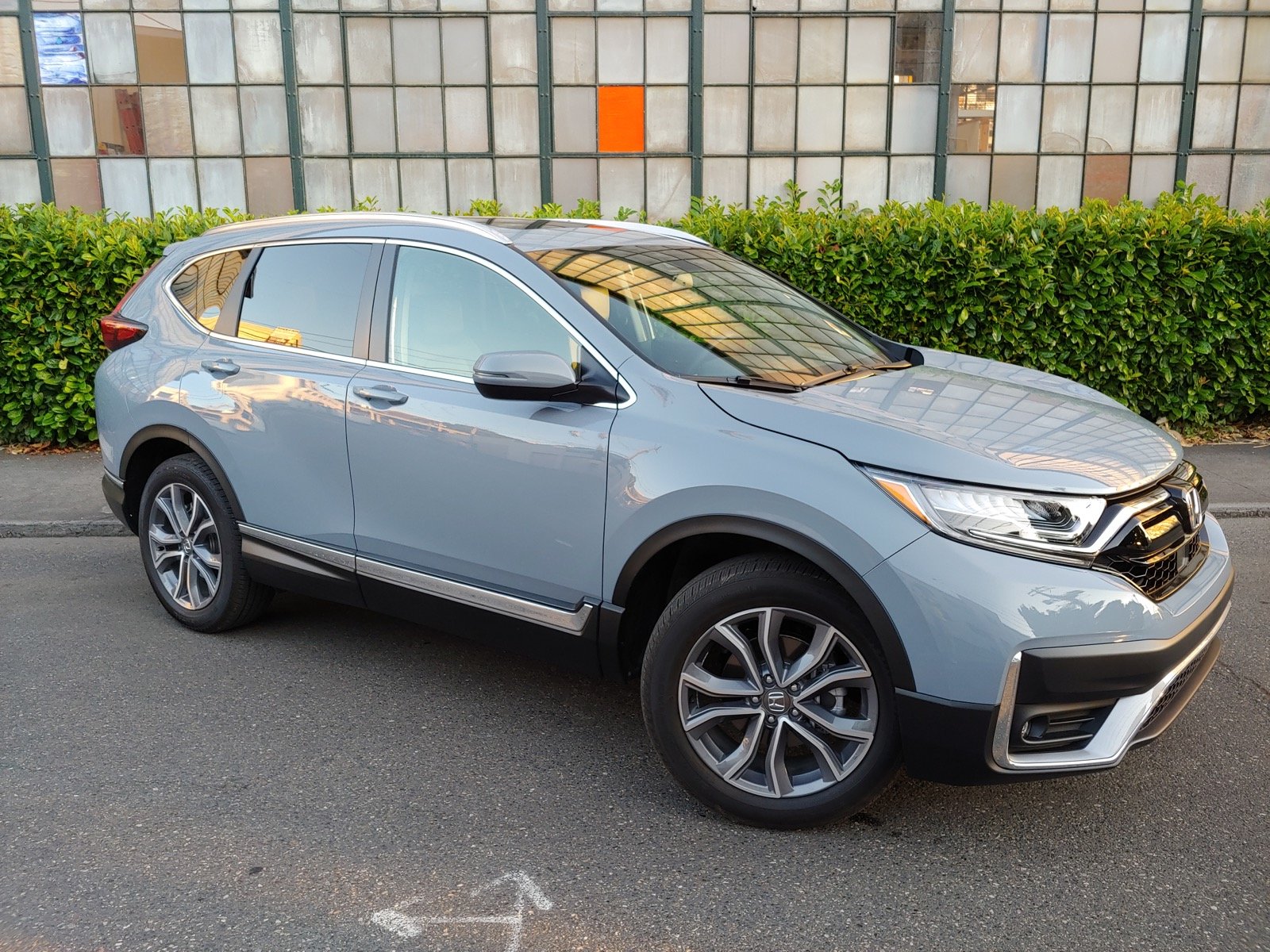
According to CarGurus experts, the overall rating for the 2020 Honda CR-V is 7.5 out of 10, while the 2021 Honda Pilot scores 7.2 out of 10. Based on these ratings, the 2020 Honda CR-V is the recommended choice, offering a better balance of performance, efficiency, and practicality for most consumers.
Choose the 2020 Honda CR-V if:
- You prioritize fuel efficiency and nimble handling in a compact crossover.
- You value a spacious interior with clever storage solutions.
- You seek a vehicle with a strong safety record and advanced driver assistance features.
Choose the 2021 Honda Pilot if:
- You need a midsize SUV with seating for up to eight people and ample cargo space.
- You want a vehicle with a powerful V6 engine and available torque-vectoring AWD.
- You appreciate family-friendly features like a rear-seat entertainment system and tri-zone climate control.
CarGurus highlights

According to CarGurus experts, the overall rating for the 2020 Honda CR-V is 7.5 out of 10, while the 2021 Honda Pilot scores 7.2 out of 10. Based on these ratings, the 2020 Honda CR-V is the recommended choice, offering a better balance of performance, efficiency, and practicality for most consumers.
Choose the 2020 Honda CR-V if:
Shop Now- You prioritize fuel efficiency and nimble handling in a compact crossover.
- You value a spacious interior with clever storage solutions.
- You seek a vehicle with a strong safety record and advanced driver assistance features.
Choose the 2021 Honda Pilot if:
Shop Now- You need a midsize SUV with seating for up to eight people and ample cargo space.
- You want a vehicle with a powerful V6 engine and available torque-vectoring AWD.
- You appreciate family-friendly features like a rear-seat entertainment system and tri-zone climate control.

By: CarGurus + AI
At CarGurus, our team of experienced automotive writers remain at the heart of our content operation, conducting hands-on car tests and writing insightful guides that are backed by years of industry experience. To complement this, we are harnessing AI to make our content offering more diverse and more helpful to shoppers than ever. To achieve this, our AI systems are based exclusively on CarGurus content, ratings and data, so that what we produce is both unique to CarGurus, and uniquely helpful to car shoppers.
